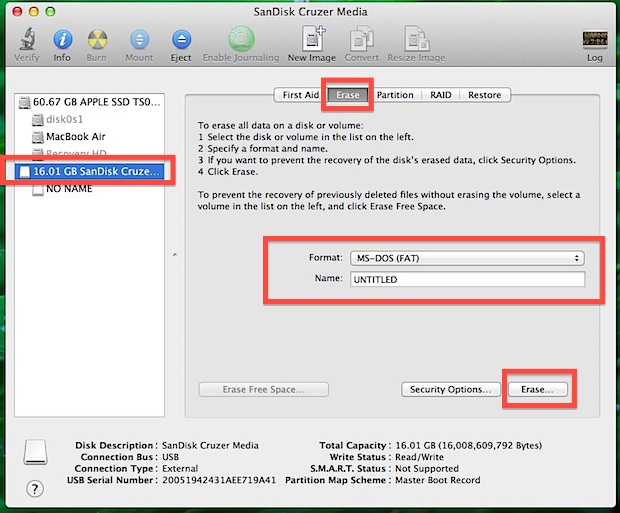

- USB FLASH DRI VE FOR MAC HOW TO
- USB FLASH DRI VE FOR MAC MAC OS X
- USB FLASH DRI VE FOR MAC INSTALL
- USB FLASH DRI VE FOR MAC UPDATE
If you want to clean up more junk on your Mac, go through each of the modules located on the left panel of the app. After all, a newly installed OS X feels better on a clean computer.ĭownload CleanMyMac and then follow the steps:Īnd you’re done. It scans your hard drive for old caches, broken apps, and app leftovers so you can remove all unwanted files in a minute or two. Among those, CleanMyMac 3 is our favorite as it looks most user-friendly of all. There are many nice apps that offer a quick Mac clean up.

Next off, do the same steps, but now replace.Īutomatic solution for system junk cleanup Note: Do not remove the folders themselves, just their insides. Go through each of the folders and remove their contents.Type in ~/Library/Caches and click Enter to go open the folder.Click on a Finder window and choose “Go to Folder” in the Go menu.The manual way to remove old user caches: If you don’t want to spend the next 20 minutes on repetitive clicking and typing, jump right to the automatic solution further down.
USB FLASH DRI VE FOR MAC MAC OS X
What's more, old caches may interfere with your new Mac OS X installation, so this step is pretty essential.Ĭleaning can be done either manually or using a dedicated app. Having cleaned them up, you may discover around 35 GB of newly created space previously taken by junk. Whatever OS X you are currently on, system junk and outdated cache files are a potential source for software conflicts. Step 1: Clean system junk on your current Mac OS X We’ve got the steps outlined below, so let’s get to it.
USB FLASH DRI VE FOR MAC INSTALL
And finally, after doing a backup, you can clean install OS X of your choice from USB. Once it’s all cleaned up, the next you should do is backup your newly cleaned Mac. First, you should clean up your Mac from the old baggage - system files that have piled up over time. To clean install Mac OS from USB, there are three things you should do. So if you’re looking to give your Mac a fresh start with just a classic Mac OS X and nothing else, to clean install Mac OS from USB is the best option for you. There are so many things you can do with past OS X - like Lion, Mavericks or Yosemite - each one of these operates flawlessly. Those who still rely on older Mac OS X operating systems, know these still are going strong. But to help you do it all by yourself, we’ve gathered our best ideas and solutions below.įeatures described in this article refer to the MacPaw site version of CleanMyMac X. The first step is to identify the USB drive device name using diskutil list.So here's a tip for you: Download CleanMyMac to quickly solve some of the issues mentioned in this article.
USB FLASH DRI VE FOR MAC HOW TO
Here, I'll describe how to do so on a Mac using a special third party toolĬalled wimlib. Official installation instructions from Microsoft,īut that only covers creating the USB drive from Windows. The solution is to split the file, as described in the One of the files in the current 64-bit version of the Windows 10 installer, Requires the USB drive be formatted as FAT32, which has a file size limit of 4 GB. This helped, but I came across a problem: the installer He suggests formatting the USB disk on the command lineĪnd copying the files over manually. I found a guide from a guy called Josh Beam


Originally it seems that you could create a bootable USB disk using MacOS's Boot Camp Assistant ,īut that option seems to've been removed in recent versions of MacOS. Special requirements in order to be bootable (it uses a special UEFI boot process). Normally I use etcher for burning ISOs, but a Windows USB installer has Wimlib and some terminal/command prompt usage. The process is straightforward, but requires one third party tool called Windows 10 disk image (ISO) file from Microsoft. If you haven't already done so, you'll need to download the This is a quick "how to" guide to make a bootable Windows 10 USB drive/stick Split size (previously 4000 MB) and suggesting legacy BIOS mode.
USB FLASH DRI VE FOR MAC UPDATE
Update : Thanks to Parul Jain for emailing in with the 3800 MB


 0 kommentar(er)
0 kommentar(er)
